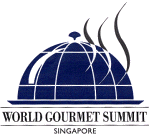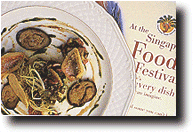
|

|

|

|

|

|
|
Dietmar Sawyere, Swiss-Australian: "It would be a shame for the classic dishes to be put on the back shelf. They need to be re-interpreted and I think it is important for countries to have this heritage and to retain it."
Susur Lee, Hong-Kong-Canadian:
Michael Caines, English:
Reto Mathis, Swiss:
Michael Mina, American:
Vichit Mukura, Thai:
Jiggs Kalra: |
From its masterclasses to its safaris, from its forum to its final gala dinner, the inaugural World Gourmet Summit (WGS) in Singapore was a resounding success.
Jointly sponsored by Singapore Tourist Promotion Board (STPB) and American Express, the event was organised by STPB assisted by Peter Knipp, former executive chef of Raffles Hotel and now editor-in-chief of the New Asia Cuisine Scene.
 It brought in top chefs from five continents who participated in master class cookery demonstrations, cooked at various venues for the WGS safari, gave their opinions at the WGS forum and cooked together at the Westin for the grand finale dinner. All of them were introduced to the media at a press conference at STPB.
Appetites were whetted and minds bombarded with new ideas and recipes throughout the WGS which formed part of the annual Singapore Food Festival. And there is eager anticipation for the next one!
It brought in top chefs from five continents who participated in master class cookery demonstrations, cooked at various venues for the WGS safari, gave their opinions at the WGS forum and cooked together at the Westin for the grand finale dinner. All of them were introduced to the media at a press conference at STPB.
Appetites were whetted and minds bombarded with new ideas and recipes throughout the WGS which formed part of the annual Singapore Food Festival. And there is eager anticipation for the next one!

After the official opening address at the forum, by STPB chief executive Dr Tan Chin Nam, presentations by the four key note speakers were made: Mary Gostelow, publisher of Tastes&Trends and contributing editor to Hospitality Industry International, on global trends and the role of New Asia Cuisine; Stanley Yen chairman of the Taiwan Visitors Association and president of The Ritz Asia Company Ltd, on Chinese culinary advancements in Asia; Michael Ginor, founder of Culinary Brainwaves, co-founder and president of Hudson Valley Foie Gras and New York State Foie Gras, on fusion and Californian cuisine, past, present and future; and Scott Webster, president of Australian Culinary Consultants, on the evolution of Australian culinary trends in the last 10 years and how it relates to Asia.
Most participants believed New Asia Cuisine was an expression of fusion, much like Californian cuisine in the 90s, with many American chefs using Asian ingredients. Like many trends it spread, with each area adapting it to suit their heritage and cuisine. It led to terms like Pacific Rim cuisine, East meets West and fusion. And in South East Asia it becoming known as New Asia Cuisine. New Asia Cuisine clearly has its soul in Asia and is being refined as it goes through its identification process and explosive growth. Opinions were, of course, divided on the specific definition for New Asia Cuisine when it was discussed at the inaugural World Gourmet Summit Forum at Suntec City, Singapore.
One or two attendees said that coming up with such a concept should not be used as it was an attempt to ‘destroy our own heritage’ while others believed that fusion cuisine was the only way to go. Peter Knipp, who organised the forum with the Singapore Tourist Promotion Board (STPB), said that without understanding local culture and cuisine one could not start to understand the New Asia Cuisine concept. The diversity of views among all panel speakers reflected individual opinions to which everyone was entitled and each contributor was right in their own special way, he said, and the important thing was to keep the discussion going.
Swiss Australian chef Dietmar Sawyere said New Asia Cuisine was a good marketing tool but pointed out that it took hundreds of years to develop a cuisine and one must know its basics before it could be blended with any other cuisine. This was reiterated by Swiss chef Reto Mathis who said too much blending could destroy flavours. Jiggs Kalra said that there was a dire need to adapt from old ways and the importance that food has as a nutritional carrier that influences the well being of people. Canadian chef Susur Lee believed New Asia Cuisine was the food of the future, particularly due to its lower fat content.
Singapore Chefs Association president, Otto Weibel, said New Asia Cuisine was taking Asian ingredients and presenting it in an international style. Some participants were concerned that such a culinary trend, if not watched properly, could become gimmicky and wondered how long it would last, as a poor evolution of nouvelle cuisine was the end of an otherwise excellent intention by its advocates and founding culinarians. What was very clear however was that all participants gave clear distinctions and answers in their own way, which is very much what describes New Asia Cuisine at best right now. |
NEW ASIA CUISINE
The facts are that restaurants and banquet venues are becoming more of a norm than just testing beds. They are, if properly implemented, very successful and more and more consumers are requesting a refreshing and modern look and taste. And while every effort must be made to maintain the classics and not to falsify them it is clear that cuisine’s have gone through evolutions in the past, as accomplished by such greats as Careme and Escoffier, and they will continue to evolve and it is the guiding principle that will determine its success and by making sure it does not follow the sorry path of nouvelle cuisine. |
| Back to WGS-97 section summary | 
|